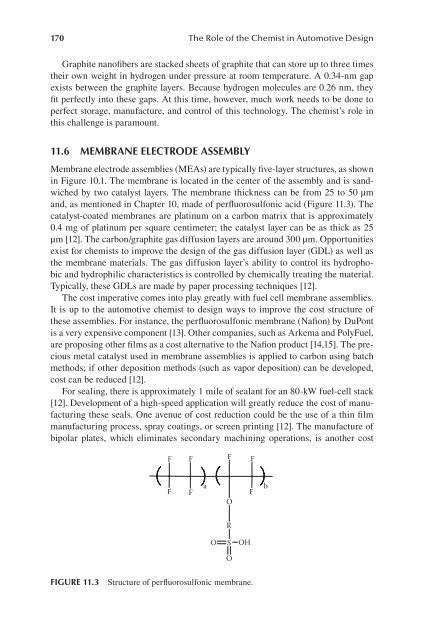THE ROLE OF THE
THE ROLE OF THE
THE ROLE OF THE
You also want an ePaper? Increase the reach of your titles
YUMPU automatically turns print PDFs into web optimized ePapers that Google loves.
170 The Role of the Chemist in Automotive Design<br />
Graphite nanofibers are stacked sheets of graphite that can store up to three times<br />
their own weight in hydrogen under pressure at room temperature. A 0.34-nm gap<br />
exists between the graphite layers. Because hydrogen molecules are 0.26 nm, they<br />
fit perfectly into these gaps. At this time, however, much work needs to be done to<br />
perfect storage, manufacture, and control of this technology. The chemist’s role in<br />
this challenge is paramount.<br />
11.6 membrane electrode assembly<br />
Membrane electrode assemblies (MEAs) are typically five-layer structures, as shown<br />
in Figure 10.1. The membrane is located in the center of the assembly and is sandwiched<br />
by two catalyst layers. The membrane thickness can be from 25 to 50 µm<br />
and, as mentioned in Chapter 10, made of perfluorosulfonic acid (Figure 11.3). The<br />
catalyst-coated membranes are platinum on a carbon matrix that is approximately<br />
0.4 mg of platinum per square centimeter; the catalyst layer can be as thick as 25<br />
µm [12]. The carbon/graphite gas diffusion layers are around 300 µm. Opportunities<br />
exist for chemists to improve the design of the gas diffusion layer (GDL) as well as<br />
the membrane materials. The gas diffusion layer’s ability to control its hydrophobic<br />
and hydrophilic characteristics is controlled by chemically treating the material.<br />
Typically, these GDLs are made by paper processing techniques [12].<br />
The cost imperative comes into play greatly with fuel cell membrane assemblies.<br />
It is up to the automotive chemist to design ways to improve the cost structure of<br />
these assemblies. For instance, the perfluorosulfonic membrane (Nafion) by DuPont<br />
is a very expensive component [13]. Other companies, such as Arkema and PolyFuel,<br />
are proposing other films as a cost alternative to the Nafion product [14,15]. The precious<br />
metal catalyst used in membrane assemblies is applied to carbon using batch<br />
methods; if other deposition methods (such as vapor deposition) can be developed,<br />
cost can be reduced [12].<br />
For sealing, there is approximately 1 mile of sealant for an 80-kW fuel-cell stack<br />
[12]. Development of a high-speed application will greatly reduce the cost of manufacturing<br />
these seals. One avenue of cost reduction could be the use of a thin film<br />
manufacturing process, spray coatings, or screen printing [12]. The manufacture of<br />
bipolar plates, which eliminates secondary machining operations, is another cost<br />
F<br />
F<br />
F<br />
F<br />
O<br />
F<br />
a<br />
F<br />
b<br />
O<br />
R<br />
S<br />
O<br />
OH<br />
FIgure 11.3 Structure of perfluorosulfonic membrane.<br />
F







